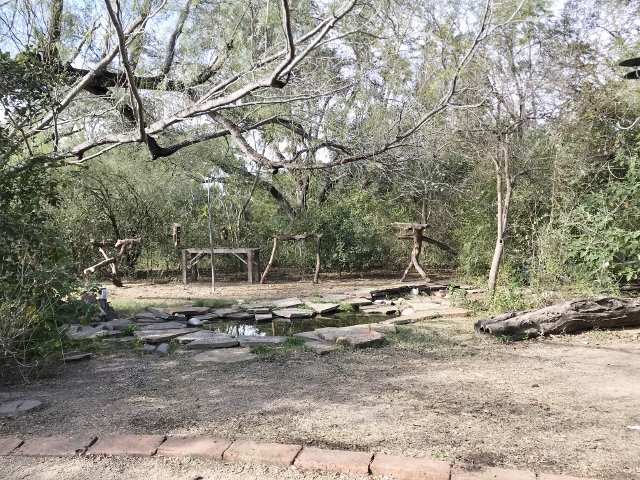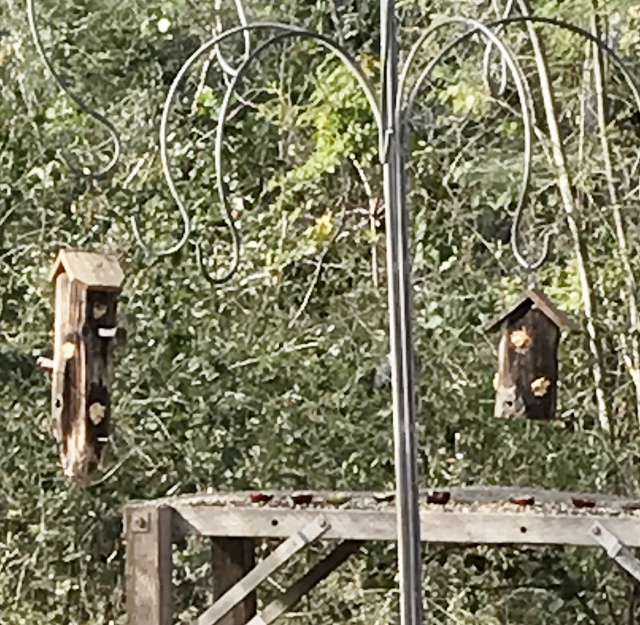I attended a fun and interesting lecture at Quinta Mazatlán, in McAllen, about Bird-friendly Urban Habitat Design. The lecture, presented by the park’s Urban Ecologist, John Brush, may be offered again in April. You’ll want to get on Quinta’s mailing list for event notifications: http://www.quintamazatlan.com/support/newsletter.aspx
During the lecture, John noted that feeding birds with seed, suet, and sugar water should be viewed as a supplement, but there are cases/situations where supplemental feeding seems to have helped species directly and indirectly, such as Anna’s Hummingbirds expanding winter range in Washington and Sharp-shinned & Cooper’s Hawks expanding in Chicago metro area.
“Feeding certainly provides easy access food that can help birds survive cold winter days,” John said. “Native plants help bird populations remain in urban areas, and feeders supplement that and bring them into easy viewing.”
John cited statistics from an article by Karin Burghardt and Douglas Tallamy that states that birds of conservation concern were 8 times more abundant in yards landscaped with natives. Overall abundance was (more or less) 1.5 times greater in native sites. Lepidopteran larval abundance was 4 times greater. Here is a link to the paper:
https://conbio.onlinelibrary.wiley.com/doi/full/10.1111/j.1523-1739.2008.01076.x
Bottom line, a yard full of lush vegetation attracts birds to feeders! Birds need shelter, food and water. Trees provide shelter so birds feel protected; trees and shrubs offer roosting and nesting sites.
The photo below is a site that was completely grass when the city of McAllen purchased Quinta Mazatlán. Native vegetation now surrounds a bird-feeding area. At the front of the photo is the edge of the walking path. The photo was taken from the “sitting gallery” directly across the path.

At 3 p.m. on a quiet Saturday afternoon, within a few minutes of sitting in the gallery — as if the birds were waiting for an audience — we observed thrushes, a Carolina wren, green jays, orange-crowned warbler, sparrows, several doves, including a ground dove, kiskadees and a few other species. While we sat and watched the show, listening to John, answer our questions, nearly 40 birds came to the feeders in about a 10-minute timeframe.
Lecture Fact — 96 percent of land birds feed insects to their young. This is important to know because native plants and trees attract insects.
John pointed out some of his favorite trees for creating a bird-friendly urban habitat as we strolled along a park trail.
- Favorite — Potato tree — for insects and fruit and no thorns
- Texas ebony — most diverse and abundant insects, as found in a local study
- Brasil — fruit and protection for roosting and nesting
- Yucca — birds eat the flowers and for nesting
- Sabal Palm — fruit and nesting
- Coma — fruit and insects for birds; fragrant flowers for the human
Feeders alone might not bring birds to your yard, but John shared a couple of park recipes that might entice birds in surrounding areas to venture to your feeders. Take a clue from nature and try placing feeders in your yard in a way that birds will feel sheltered. Ensure food is in the feeders everyday.
Seed mixture for tray-type feeders: Mixture of milo, cracked corn and black-oil sunflower seeds
Suet recipe for special feeders:
- 1 part peanut butter
- 1 part flour
- 1 part lard
- 2 parts corn meal
Wearing food-serving or rubber gloves (optional) combine ingredients and mix thoroughly by hand.
Hand-constructed wooden hanging feeders, with cavities for the suet/peanut butter mixture, and dowel-like perches near the cavities — can be hung from a shepherd’s-hook near seed feeders. Google suet/peanut butter bird feeders for other options.
Behind the two suet feeders in the below photo, is an elevated wooden trough-like feeder that holds seeds and fruit. It is covered by a fit-to-size section of wire, like hardware cloth (which is really wire, not fabric) so animals can’t easily snatch the fruit intended for the birds.

Shallow water features are an asset to attracting birds. Dripping water attracts birds. An easy-to-put-together, effective water feature is a large shallow clay pot-type saucer, filled with water, with a “landing pad” flat rock placed in the water. To create movement of the water, paint a gallon jug a flat, dark green, poke a tiny hole in one corner, fill the jug with water, put the lid on the jug. With rope or chain, suspend the jug by its handle over the water-filled saucer, again using a “shepherd’s-hook” type stand. Let the water drip — one drop about every 15 seconds — into the saucer. When suspended, the jug hangs at an angle, you’ll want the tiny hole in that downward corner at the bottom of the jug.
John shared tips about some of the Valley birds:
Kiskadees are a fly catcher, but also highly omnivorous. They also are predators and eat meat like mice and lizards, as well as fruit of the native plant, Turk’s cap.
Golden fronted woodpeckers are cavity nesters and are the birds that make most of the holes in the dead palm tree trunks.
Black-crested titmice are secondary cavity-nesters — taking over abandoned cavities
Lush vegetation yard birds: Green jays, plain chachalacas, Inca doves
Facts and fun information about Texas ebony and brasil trees that I’ve compiled for PowerPoint presentations about attracting wildlife with native plants:
Texas Ebony, Chloroleucon ebano
- Can reach 50 feet tall
- Legume
- Keeps leaves all year
- Blooms summer and before a rain
- Magnitude of short, paired (wicked) spines
- Slow growing
- Wildlife – cover, roosting, nesting sites and protection for birds
- Host to some sulfurs, blues, skipper butterflies
- Javelina, deer, small mammals and insects eat leaves, seed pods, seeds
- Flowers – bees, butterflies and other beneficial pollinators
- Excellent specimen for an indoor bonsai – can grow from cuttings
Brasil, Condalia hookeri
- Bright, lime-green leaves
- Tolerates drought
- Full sun
- Dry, well-drained soils of sandy loam, clay or caliche
- Heights to 30 feet; usually smaller in our area.
- Leaves remain all year on light-gray branches until new leaves begin pushing out in spring
- Tiny green flowers bloom summer and fall
- Green berries turn red, then black when ripe
- Blooms and fruits at the same time offering food for wildlife through two seasons
- Sweet, edible berries — popular for making jelly and wine
- Coyotes, raccoons, squirrels, opossums and quail also vie for the coveted berries
- Leaves browsed by deer
- Protection to birds for roosting and nesting
- Branch tips end in sharp thorns
- Security hedge – impenetrable thorny thicket keeping humans at bay while sheltering small mammals, quail and other critters from predators
- Ripe fruit makes purple dye
- Grown from cuttings, seeds collected from ripe fruit or plants purchased from local native plant growers.
Excerpts from an earlier published article:
The potato tree is more entertaining than a circus, by Anita Westervelt
The potato tree, Solanum erianthum, is a large-leaved, small, fast-growing native tree with an airy, flat-topped umbrella-like shape. The tree can withstand rugged pruning and can be shaped to fit a space. The wood is soft and brittle and easily trimmed with loppers, but branches are strong enough to support large birds such as chachalacas.
The leaves have a fine, hairy covering that give the tree its grayish-green pastoral look. Though not dramatic, the delicate, furry white flowers bloom spring to winter. The cluster quickly produces round green fruits that turn various shades of yellow and orange as they ripen. Chachalacas and other critters eat the berries. The unripe fruit itself is a nectar source for butterflies, like tawny and hackberry emperors.
An endless number of visitors come to the leaves. Stink bugs lay eggs on the leaves and the resulting larvae provide food for lizards. Flies, wasps, bees, bugs and a variety of butterflies and moths use the leaves as a resting place. Wasps and beetles seem to get drunk on the ripened fruit when it splits open. Some birds eat the leaves. Ants use the branches as a thoroughfare at dawn on their way to work.
The potato tree is a Mexican, South American and Caribbean native; the Lower Rio Grande Valley and Southern Florida is its most northern reach.
The tree is a host plant for the creamy stripe-streak butterfly, Arawacus jada, a rare stray to southern North America from Mexico.
— 30 –

Leave a Reply